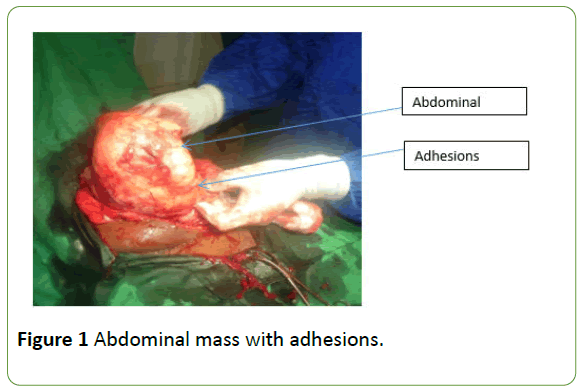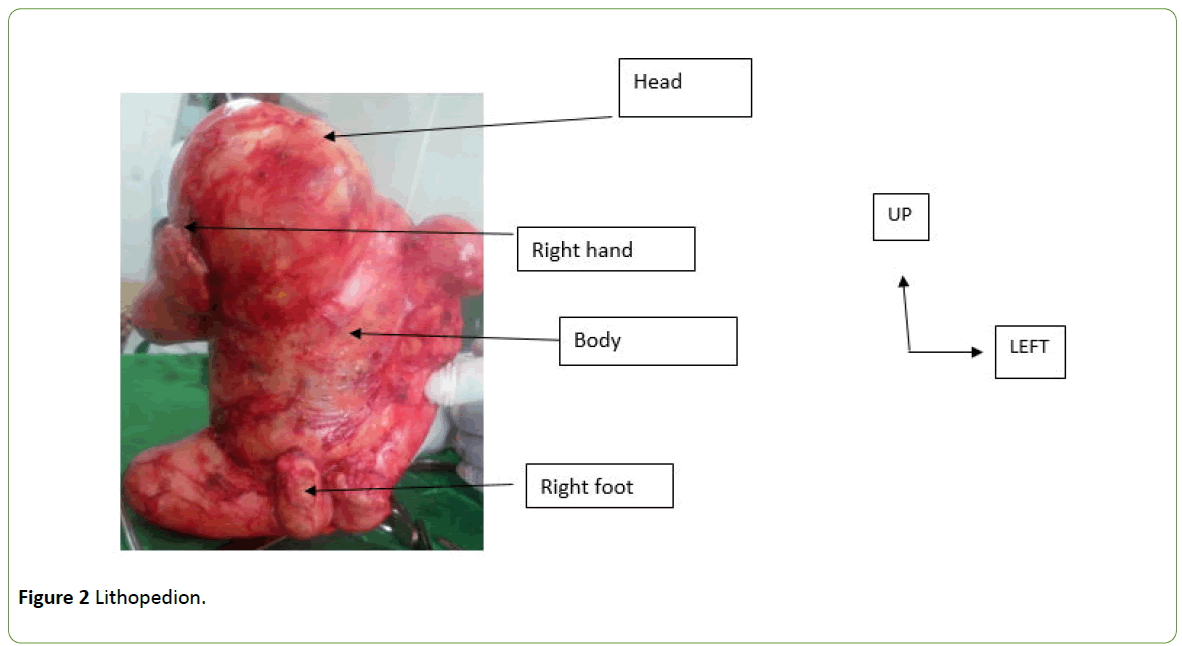Aboubakari Abdoul-Samadou1, Douaguibe Baguilane2*, Logbo-Akey Kossi Edem1, Ajavon Regina Dede1, Dagbe Massaga3, Bassowa Akila2, Ketevi Ayoko A2 and Akpadza Koffi2
1Department of Gynecology and Obstetrics, Kara Teaching Hospital, Kara, Togo
2Department of Gynecology and Obstetrics, Campus Teaching Hospital, Lome, Togo
3Department of Radiology and Medical Imaging, Kara Teaching Hospital, Kara, Togo
- *Corresponding Author:
- Douaguibe Baguilane
Department of Gynecology and Obstetrics, Campus Teaching Hospital, Kara, Togo
Tel: (00228) 90328262
E-mail: douaguibe@hotmail.com
Received Date: April 28, 2019; Accepted Date: June 03, 2019; Published Date: June 10, 2019
Citation: Abdoul-Samadou A, Baguilane D, Kossi Edem LA, Dede AR, Massaga D, et al. (2019) Lithopedion Simulating Uterine Fibroid: A Case Study at the Kara Teaching Hospital. Gynecol Obstet Case Rep Vol.5: No.2:77.
Background: Lithopedion, a rare form of abdominal pregnancy, can simulate a uterine fibroid.
Objective: To describe a case of lithopedion simulating uterine fibroid.
Case report: A 42-year-old female received for chronic abdominal pain and constipation. Eight (8) years ago, she had a history of a completed pregnancy without any effective delivery. Her abdomen was distended, depressible. The palpation conducted revealed a hard, irregular, motionless and median abdominopelvic mass going back to the epigastrium. A ultrasonography study revealed an empty uterus with a seat of three large fibroids and a moderate bilateral pelvicalyceal dilatation. A laparotomy, by midline incision under the umbilical had objectified a median abdominal mass covered with intestinal and omental adhesions. After adhesiolysis, a calcified baby of 2.700 g was removed.
Conclusion: The lithopedion can simulate uterine fibroid in our African environment where the prenatal follow-up is irregular. The plain abdomen x-rays helped the diagnostic but not done in first intention because uterine fibroid is very frequent in black women.
Keywords
Lithopedion; Uterine fibroid; Kara CHU; Togo
Introduction
Lithopedion is an abdominal pregnancy in which the fetus dies and calcifies. Also called a stone baby, it is a rare pathology, described for the first time in the 10th century by Albucasis [1]. Its frequency varies from 1.5 to 1.8% of abdominal pregnancies and it represents one case in 11000 pregnancies. Less than 300 cases have been described in the last 400 years in the world medical literature [2-6]. This pathology occurs under some conditions such as abdominal pregnancy with fetal death after 3 months; without any ovular infection and early diagnosis. After death, the fetal tissues undergo dehydration and calcification [3,4,6]. Lithopedion exists in several forms. Lithokelyphos corresponds to the calcification of amniochorial membranes with the fetus being at different stages of decomposition. In lithokelyphopedion, the fetus and amniochorial membranes are calcified. Lithopedion is the calcification of the fetus only [6].
We are reporting the first case of intra-operative discovery of a lithopedion at the Kara teaching Hospital. A hospital located in Kara, the second town in the North of Togo.
Case Report
It is about a 42-year-old mother of two living children, who came for a consultation of chronic abdominal pains and constipation. Her last delivery occurred 10 years ago. Eight years ago, she had a pregnancy that was carried out without any effective delivery. It was followed by a decrease in abdominal volume leaving persistent distention and abdominopelvic gravity. Her menstrual cycle had resumed two years later and remained regular. The general condition of the patient was preserved. She did not lose any weight and had no cutaneous mucous pallor.
The abdomen was distended, depressible. There was a hard, irregular, immobile, medial abdominopelvic mass going back to the epigastrium. The vulva, the vagina and the cervix were normal. The uterus was in the pelvic area, but unified with the abdominopelvic mass.
An ultrasonography test revealed an empty uterus, the seat of three large fibroids and moderate bilateral pelvicalyceal dilatation. Neither the hospital nor the north area has Intravenous urography or abdominopelvic CT and CT urography tests. Her serum creatinine was 8 mg/l for a normal value below 12 mg/l. we didn’t do the plain abdomen x-rays.
By spinal anesthesia we made a median umbilical incision Laparotomy. We discovered a median abdominal mass covered by intestinal and omental adhesions (Figure 1).
Figure 1: Abdominal mass with adhesions.
There was no gestational sac, the uterus and the ovaries were normal, and the uterine horns had a bull-like appearance. The amniochorial membranes were calcified and adherent to the fetus with the absence of a placenta and the amniotic fluid. We performed a very had and difficult adhesiolysis and then removed a calcified baby weighing 2.700 g (Figure 2).
There was no lesion of the neighboring organs or vascular lesions. The abdominal wall was closed plan by plan. The follow-up was simple and the patient was discharged from the hospital on the fourth post-operative day. Postoperative visits from one month and 6 months were normal.
Discussion
Lithopedion is an old stopped and calcified abdominal pregnancy. In some rare cases, the diagnosis was made during a surgical procedure [1]. We report a case of peroperative diagnostic of lithopedion. Lithopedion is increasingly becoming rare nowadays due to improved access to prenatal consultations leading to early diagnosis and treatment [3,6]. This rarity of cases explains the old references in literature. The weaker socio-economic conditions and the lower level of education of the population often lead a delay of the first prenatal consultation or even the complete absence of a follow-up of the pregnancy. This results in the non-diagnosis of this ectopic pregnancy and its transformation into a lithopedion [1].
The patient in our case was 42 years old and the duration of the retention of the fetus was 8 years. In the available literature, the age of the patients varies from 23 to 100 years. Two-thirds of the patients were often over 40. The duration of the retention of the fetus varies from 4 to 60 years. [4,6]. The fetus dies between 3 and 6 months in 27% of the cases, 7 to 8 months in 27% of the cases, [4,6]. Abdominal pregnancy has reached its end in our case with a fetus weighing 2.700 g. Lithopedion often remains asymptomatic for several years. Sometimes, as in our case, abdominopelvic pains, sensation of abdominal mass or symptoms of bladder compression (pollakiuria, dysuria) or rectal compression (constipation, tenesmus) leads to a diagnosis [4,5]. The diagnosis often suspected on clinical examination are often confirmed later by plain abdomen x-rays (calcified fetus). The lithopedion case was not suspected at all on clinical examination in our case, despite the history of a pregnancy without any delivery. First we didn ’ t think about any lithopedion case because of its scarceness.
Secondary, a black woman presenting abdominal mass with irregular borders brought us to think about a fibroids case because of the frequency of this pathology. Abdominal ultrasound showed an empty uterus and a nonspecific abdominal mass. We must now begin thinking of the lithopedion cases to suspect it. A plain abdomen x-rays was not performed in our study because of the ultrasound diagnosis of polyfibroids uterus. The CAT scan of abdomen would help us to correct the diagnostic and see the associated pathologies.
The intravenous urography makes it possible to look for a urinary compression [4-6]. The Urinary compression in the form of pelvicalyceal dilatation observed in our case isn’t specific sign of lithopedion. Any important abdomen mass can lead to pelvicalyceal dilatation by compression. We preoperatively retained the diagnosis of complicated uterine fibroids with urinary system compression and decided to carry out an exploratory laparotomy. In fact, the differential diagnosis is made up with an ovarian tumor, the uterine fibroid or a bladder tumor [6]. The care to be provided remains uncodified. Indeed, while some authors advocate surgical treatment to remove the calcification, others prefer stability care taking by considering the outweighing effects over the benefits [4,7]. The surgical treatment provided, as in our case, consisted in the removal of the mass to avoid long-term complications [8]. This surgery was carried out without any difficulty. No per-surgical deaths reported, but attention should be paid to intestinal and bladder adhesions [5,6].
Conclusion
A lithopedion is an old abdominal pregnancy with the death and the calcification of the fetus. This case, although it is rare one, can be observed and it can simulate a uterine fibroid in our African environment where prenatal care is lacking. Uterine fibroids are very common place. We must therefore think about the concept of advanced pregnancy which is not completed by childbirth.
References
- Lachman N, Satyapal KS, Alideen JMK, Moodley TR (2001) Lithopedion: A case report. Clin Anat 14: 52-54.
- Ramos-Andrade D, Ruivo C, Portilha MA, Brito JB, Caseiro-Alves F, et al. (2014) An unusual cause of intra-abdominal calcification: A lithopedion. European J Rad Open 1: 60-63.
- Costa SD, Presley J, Bastert G (1991) Advanced abdominal pregnancy. Obstet Gynecol Surv 46: 515-525.
- Frayer CA, Hibbert ML (1999) Abdominal pregnancy in a 67-year-old woman undetected for 37 years: A case report. J Reprod Med 44: 633-635.
- Irick MB, Kitsos CN, O’Leary JA (1970) Therapeutic aspects in the management of a lithopedion. Am Surg 36: 232-234.
- Spiritos NM, Eisenkop SM, Mishell DR (1987) Lithokelyphos: A case report and literature review. J Reprod Med 32: 43-46.
- Kim MS, Park S, Lee TS (2002) Old abdominal pregnancy presenty as ovarian neoplasm. J Korean Med Sci 17: 274-275.
- Bonahy AA, Sabbah H, Abdeljelil AB, Mahmoudi M (2016) Mummified abdominal pregnancy. Pan Afr Med J 25: 230.



